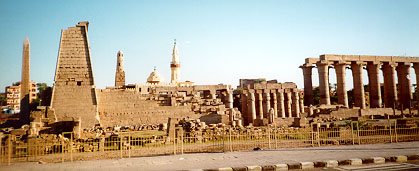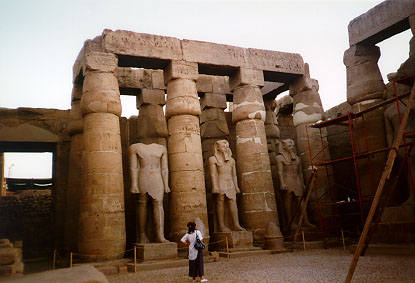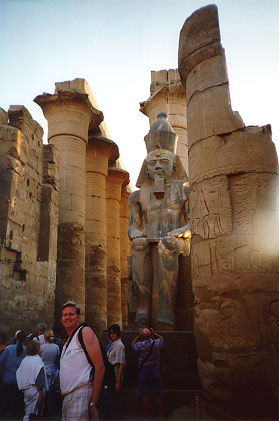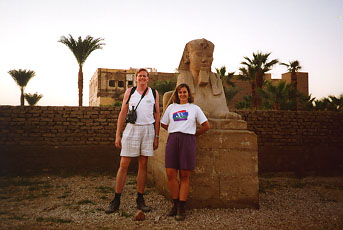
The Temple of Amun at Luxor
![]()
| The Temple of Amun, located on the East Bank, was built by two Pharaohs: Amenhotep III (1390 - 1352 BCE) and Ramesses II (1279 - 1213 BCE). The temple was dedicated to Amun, whose marriage to Mut was celebrated annually when the sacred procession moved by boat from Karnak to Luxor Temple. The primary function of the original temple was as a setting for the Festival of Opet, in which the cult statue of the god Amun was carried annually along an avenue of sphinxes leading from the temple of Amun at Karnak to Luxor. |
![]()
The entrance
is a huge pylon built by Ramesses
II and has
two seated statues of the
pharaoh.
Originally, two large obelisks, also added
by Ramesses II, stood in front of the pylon. However, only one remains. The other, given to
France in 1819, now stands in Place de la Concorde in Paris.
 A side view of the
temple of Amun showing most of the ruins. The
Mosque of Abu'l Haggag which partially
overbuilt the temple can be seen as well as the Court
of Ramesses II and the colonnade
of
Amenhotep II.
A side view of the
temple of Amun showing most of the ruins. The
Mosque of Abu'l Haggag which partially
overbuilt the temple can be seen as well as the Court
of Ramesses II and the colonnade
of
Amenhotep II.
 Beyond the entrance
pylon of temple is the Court of
Ramesses II. The colonnade of closed papyrus-bud columns, which originally lined the
court on all four sides, today is interrupted in the northeast corner by the presence of
the Mosque of Abu'l Haggag. Standing statues of Ramesses II punctuate most of the spaces
between the columns. The crowns of several of these figures sit on the ground beside them
because they were carved separately and have fallen off.
Beyond the entrance
pylon of temple is the Court of
Ramesses II. The colonnade of closed papyrus-bud columns, which originally lined the
court on all four sides, today is interrupted in the northeast corner by the presence of
the Mosque of Abu'l Haggag. Standing statues of Ramesses II punctuate most of the spaces
between the columns. The crowns of several of these figures sit on the ground beside them
because they were carved separately and have fallen off.
 The colonnade
within the court of Amenhotep II consists
of 14 columns with papyrus capitals. In the entrance to the colonnade are two statues
bearing the name of Ramesses II but the features of Tutankhamen.
The colonnade
within the court of Amenhotep II consists
of 14 columns with papyrus capitals. In the entrance to the colonnade are two statues
bearing the name of Ramesses II but the features of Tutankhamen.
 One of the remaining
sphinxes at Luxor. These sphinxes
combine the body of a lion with the head of Nectanebo I (380-363 BCE). They were
rebuilt in the fourth century BCE to replace the ruined New Kingdom sphinxes.
One of the remaining
sphinxes at Luxor. These sphinxes
combine the body of a lion with the head of Nectanebo I (380-363 BCE). They were
rebuilt in the fourth century BCE to replace the ruined New Kingdom sphinxes.
© All pictures are Copyright 1998 - 2000 Grisel Gonzalez